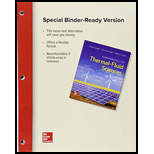
(a)
The ratio of flow rates of hot and cold water as they enter the T-elbow.
(a)
Explanation of Solution
Given:
The maximum flow rate
The reduced flow rate
The temperature of the hot stream
The temperature of the hot stream
The temperature of the mixed stream
The duration of the shower
The specific heat of water
The number of person
Calculation:
Here, the two streams (comparatively hot and cold) of fluids are mixed in a rigid mixing chamber and operates at steady state. Hence, the inlet and exit mass flow rates are equal.
Write the energy rate balance equation for two inlet and one outlet system.
Here, the rate of heat transfer is
The system is at steady state. Hence, the rate of change in net energy of the system becomes zero.
Neglect the heat transfer, work transfer, kinetic and potential energies.
The Equation (II) reduced as follows.
Substitute
The change in enthalpy is expressed as follow.
Here, the specific heat is
Substitute
Thus, the ratio of flow rates of hot and cold water as they enter the T-elbow is
(b)
The amount of electricity that will be saved per year, in
(b)
Explanation of Solution
Refer Table A-3 (a), “Properties of common liquids, solids, and foods”.
The specific heat at constant pressure
The density of the water
Here, the volume flow rate in the shower heads is lowered by installing low-flow shower heads equipped with flow controllers. This reduces the volume flow rate of water that is consumed per person.
Calculate the volume flow rated saved.
Calculate the total volume flow rate saved by the family per year.
Calculate the total mass of water saved per year.
Calculate the energy saved due to the installation of lower shower heads.
Thus, the amount of electricity that will be saved per year, in
Want to see more full solutions like this?
Chapter 6 Solutions
Loose Leaf For Fundamentals Of Thermal-fluid Sciences Format: Looseleaf
 Elements Of ElectromagneticsMechanical EngineeringISBN:9780190698614Author:Sadiku, Matthew N. O.Publisher:Oxford University Press
Elements Of ElectromagneticsMechanical EngineeringISBN:9780190698614Author:Sadiku, Matthew N. O.Publisher:Oxford University Press Mechanics of Materials (10th Edition)Mechanical EngineeringISBN:9780134319650Author:Russell C. HibbelerPublisher:PEARSON
Mechanics of Materials (10th Edition)Mechanical EngineeringISBN:9780134319650Author:Russell C. HibbelerPublisher:PEARSON Thermodynamics: An Engineering ApproachMechanical EngineeringISBN:9781259822674Author:Yunus A. Cengel Dr., Michael A. BolesPublisher:McGraw-Hill Education
Thermodynamics: An Engineering ApproachMechanical EngineeringISBN:9781259822674Author:Yunus A. Cengel Dr., Michael A. BolesPublisher:McGraw-Hill Education Control Systems EngineeringMechanical EngineeringISBN:9781118170519Author:Norman S. NisePublisher:WILEY
Control Systems EngineeringMechanical EngineeringISBN:9781118170519Author:Norman S. NisePublisher:WILEY Mechanics of Materials (MindTap Course List)Mechanical EngineeringISBN:9781337093347Author:Barry J. Goodno, James M. GerePublisher:Cengage Learning
Mechanics of Materials (MindTap Course List)Mechanical EngineeringISBN:9781337093347Author:Barry J. Goodno, James M. GerePublisher:Cengage Learning Engineering Mechanics: StaticsMechanical EngineeringISBN:9781118807330Author:James L. Meriam, L. G. Kraige, J. N. BoltonPublisher:WILEY
Engineering Mechanics: StaticsMechanical EngineeringISBN:9781118807330Author:James L. Meriam, L. G. Kraige, J. N. BoltonPublisher:WILEY





